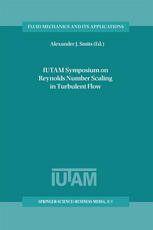

Most ebook files are in PDF format, so you can easily read them using various software such as Foxit Reader or directly on the Google Chrome browser.
Some ebook files are released by publishers in other formats such as .awz, .mobi, .epub, .fb2, etc. You may need to install specific software to read these formats on mobile/PC, such as Calibre.
Please read the tutorial at this link: https://ebookbell.com/faq
We offer FREE conversion to the popular formats you request; however, this may take some time. Therefore, right after payment, please email us, and we will try to provide the service as quickly as possible.
For some exceptional file formats or broken links (if any), please refrain from opening any disputes. Instead, email us first, and we will try to assist within a maximum of 6 hours.
EbookBell Team

4.0
96 reviewsThis volume presents selected papers from the IUTAM Symposium on Reynolds Number Scaling in Turbulent Flow, convened in Princeton, NJ, USA, September I1-13, 2002. The behavior ofturbulence at high Reynolds number is interesting from a fundamental point of view, in that most theories of turbulence make very specific predictions in the limit of infinite Reynolds number. From a more practical point of view, there exist many applications that involve turbulent flow where the Reynolds numbers are extremely large. For example, large vehicles such as submarines and commercial transports operate at Reynolds 9 numbers based on length ofthe order oft0 , and industrial pipe flows cover a 7 very wide range of Reynolds numbers up to 10 • Many very important applications of high Reynolds number flow pertain to atmospheric and other geophysical flows where extremely high Reynolds numbers are the rule rather than the exception, and the understanding of climate changes and the prediction of destructive weather effects hinges to some extent on our appreciation ofhigh-Reynolds number turbulence behavior. The important effects of Reynolds number on turbulence has received a great deal of recent attention. The objective of the Symposium was to bring together many of the world's experts in this area to appraise the new experimental results, discuss new scaling laws and turbulence models, and to enhance our mutual understanding of turbulence.